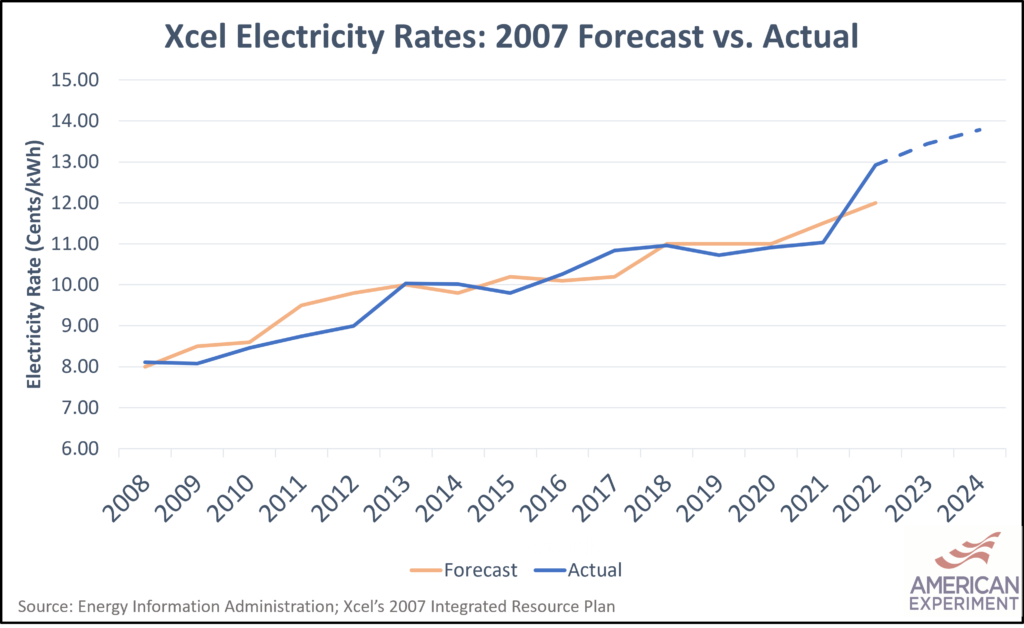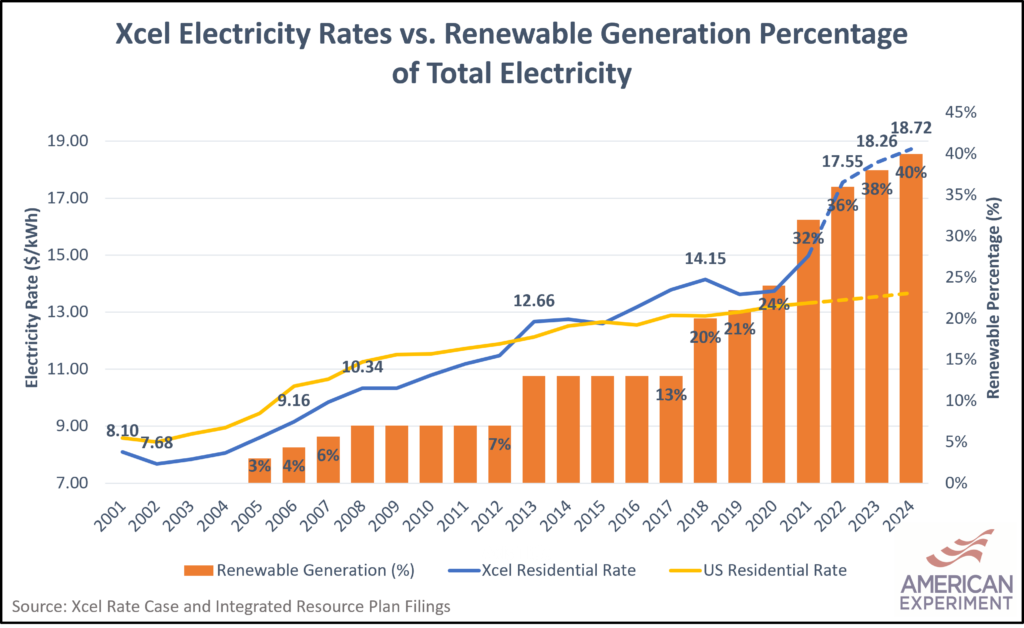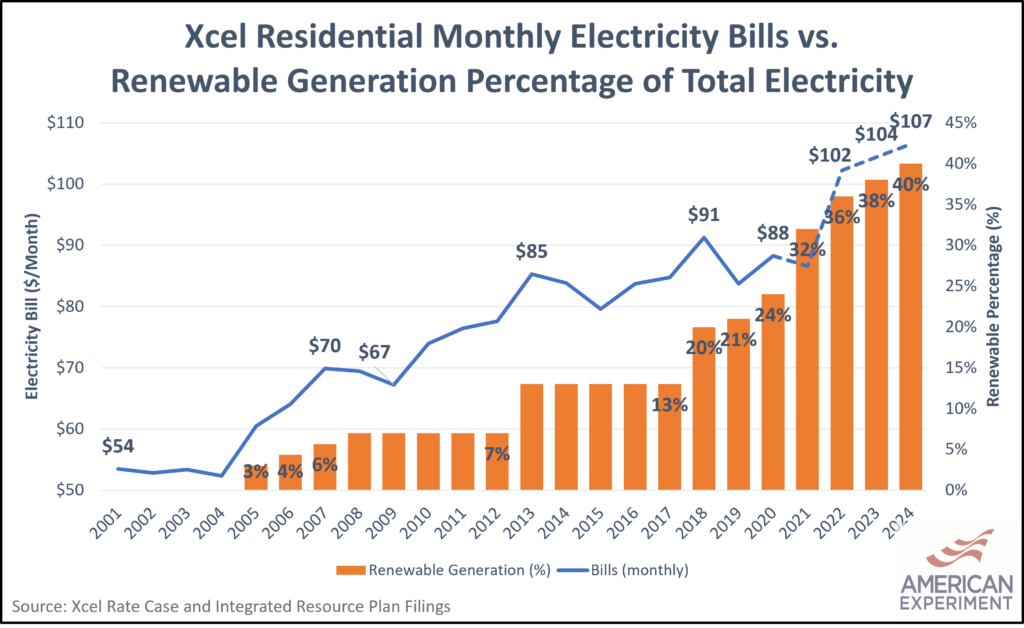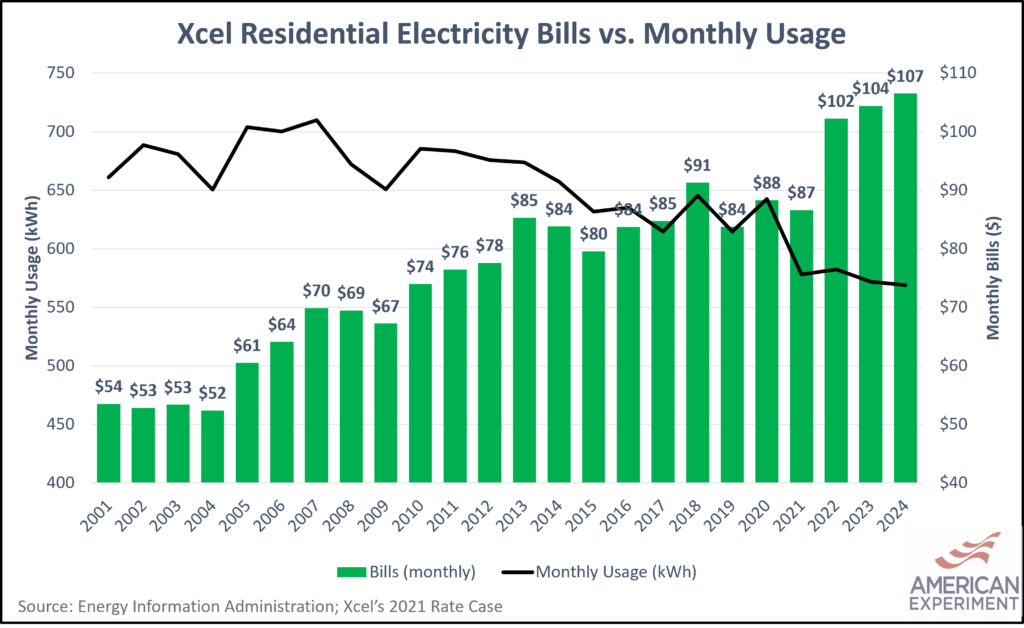Five graphs that show how the high-cost wind and solar are driving up Xcel Energy costs for Minnesotans
Xcel Energy recently requested approval to increase electricity rates from the Minnesota Public Utilities Commission (PUC). This rate increase, if approved by the PUC, would increase residential customer bills by $15 to $21 per month by 2024.
As the company noted in its rate case filing, hiking up electricity rates would allow Xcel to continue “expanding our [Xcel’s] renewable energy portfolio and further transforming our generation fleet as we lead the clean energy transition…”
Unfortunately, this has become a decades-long trend. Xcel has been using the high cost of wind and solar energy as a justification for rate increases as early as 2007 when the first statewide renewable energy mandate passed with the Next Generation Energy Act (NGEA) into law. This mandate required 30 percent of Xcel’s electricity sales to come from renewable energy sources by 2020.
Immediately after the NGEA passed, Xcel’s 2007 Integrated Resource Plan (IRP) proposed building 2,600 megawatts (MW) of new wind capacity and 2,300 MW of new “wind-following” natural gas capacity by 2022. Xcel did not mince words as to why costs were increasing, describing rising costs as “the actions needed to comply with expansive new legislation regarding carbon management, renewable energy, and demand-side management (“DSM”) adopted by the 2007 Minnesota Legislature.”
Xcel’s 2007 documents estimated it would be incredibly expensive to comply with the renewable energy mandate, and that this would lead to higher rates. The graph below shows how much Xcel thought the NGEA would increase prices and compares it to the actual increase in prices since the passage of the NGEA.

Xcel projected average electricity rates to reach roughly 12 cents per KWh in 2022 due to having to comply with Minnesota’s renewable energy mandate. If Xcel’s latest rate increase is approved by the Minnesota PUC, rates will reach nearly 13 cents per KWh in 2022 after increasing by 37.5 percent since 2008 — but it didn’t have to be this way.
The Minnesota PUC has the power to delay or waive compliance with the state’s renewable energy mandates if it is too expensive for ratepayers. The PUC chose not to do this, instead approving Xcel’s plans regardless of the cost increases.
Xcel’s 2007 plan has largely come to life. According to its latest IRP, Xcel currently owns or contracts 2,600 MW of wind and roughly 1,000 MW of solar. To pay for the costs associated with building this amount of renewable energy capacity within 14 years, Xcel has increased electricity rates on its customers a total of eight times from 2008 to 2021 — all approved and sanctioned by the Minnesota PUC.
After once having residential, commercial and industrial electricity rates at 12 percent, 27 percent, and 18 percent below the national average, respectively, Xcel will now be above the national average in every rate class. In fact, Xcel is currently one of the top 25 percent most expensive utility companies in the country for residential households.
The graph below shows that as Xcel’s renewable energy generation grew to comply with Minnesota’s renewable energy mandate, residential electricity rates increased by 64 percent — from 9 cents per KWh in 2006 to nearly 15 cents per KWh in 2021.

For comparison, the national average for residential electricity customers increased by only 28 percent during the same timeframe — meaning residential electricity rates at Xcel increased over 2 times faster than the national average since 2006.
Unfortunately, higher electricity rates mean higher electricity bills.
As the graph below shows, Xcel’s latest rate increase would cause residential electricity bills to grow to nearly $110 per month by 2024 — a 66 percent increase since 2006.

Even worse, this means electricity bills will be roughly 21 percent higher in 2024 than in 2020, despite Xcel projecting monthly household KWh to decrease by 11.5 percent.
The graph below shows that Xcel residential electricity bills have increased by over 100 percent since their 2004 low, despite monthly household electricity usage dropping from a high of 700 KWh per month to nearly 550 KWh per month in 2024.

If you use less, you should pay less — but that’s not the case with Xcel.
Xcel’s annual electricity sales have fallen by 13 percent since 2007, as you can see in the graph below. However, the utility company never cut down on spending in the face of decreasing electricity sales because the PUC did not require Xcel to delay compliance with the state’s renewable energy mandate.
As a result, Xcel continued to invest in expensive renewable energy facilities that drive up the cost of electricity. This forced Xcel to increase electricity rates to pay for the rising costs brought on by massive investments in wind and solar and to recover these costs over fewer sales.

Xcel explained this trend in its 2010 IRP, when it was in the process of complying with Minnesota’s renewable energy mandate. As the company noted, the “implementation of the proposed plan will nonetheless require rate increases to our customers. The pace of our investment and the fact that much of it is not supported by load growth makes the method of determining rates a more critical issue.”
That last part is critical to understand: Xcel’s renewable energy investments since 2007 were never about the company’s ability to support load growth (i.e., increasing sales), but to satisfy renewable energy mandates imposed by the Minnesota legislature. This would be like Target investing in more retail stores despite sales plummeting — a recipe for bankruptcy.
While a negative correlation between sales and revenues is almost unheard of in the free market, Xcel can get away with this because it is a regulated monopoly utility company and has no fear of losing customers due to the high cost of service, as it has no direct competitors.
Furthermore, Xcel’s annual revenue is not determined by electricity sales, but in advance by a revenue formula determined by the PUC. As such, Minnesota PUC commissioners are just as much to blame as Xcel for increasing prices, because they are the ones charged with approving Xcel’s required revenue every year.
While many things go into the revenue requirement formula, the basic idea is that the expenses associated with providing electricity (i.e., fuel costs, salaries, etc.) are passed directly onto customers, plus a 9.2 percent return for Xcel on un-depreciated assets like wind turbines, solar panels, coal plants and transmission lines.
This means Xcel does not earn a profit on the electricity it sells, but the infrastructure it builds, and that ratepayers essentially pay Xcel 9.2 percent interest whenever the company builds new infrastructure.
In this way, Minnesota’s renewable energy mandates acted as a blank check to utilities like Xcel by requiring them to build an enormous amount of infrastructure over a short period — allowing them to profit massively at the expense of ratepayers.
And despite Xcel successfully meeting the requirements of Minnesota’s renewable energy mandate, PUC commissioners have allowed Xcel to continue investing in renewable energy sources, even calling for the utility to invest more in renewables in the heat of the COVID-19 pandemic. This means that Xcel’s current rate increase request on Minnesota families and businesses is designed solely to accomplish Xcel’s internal company goal of achieving 80 percent carbon-free by 2030, and not to meet rising consumer demand for electricity.
In other words, energy policy in Minnesota is being directed by the whims of a profit-seeking monopoly company, and not Minnesota ratepayers.
In the absence of any opposition from PUC commissioners, Xcel Energy currently faces no obstacles to increasing electricity rates on its customers except for the Center of the American Experiment. We are the only organization currently asking PUC commissioners to hold off on approving any Xcel plan that would continue to increase electricity rates on Minnesotans by investing in unnecessary renewable energy facilities.